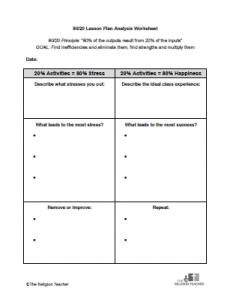 You’re overwhelmed. Nothing seems to be working in your classroom. Stress levels rise with each new day. Why won’t these kids listen? Why am I constantly getting blank stares? Why won’t they just sit still and pay attention? I’ll never get all of this information covered today let alone this entire year!
You’re overwhelmed. Nothing seems to be working in your classroom. Stress levels rise with each new day. Why won’t these kids listen? Why am I constantly getting blank stares? Why won’t they just sit still and pay attention? I’ll never get all of this information covered today let alone this entire year!
Maybe your life as a religious educator isn’t quite that bad, but we all have stress in our work in catechesis. We also have a lot of successes, though we are often too humble to admit it.
The 80/20 Analysis
In my own personal productivity system, I have picked up on a great technique called an 80/20 Analysis. It is based on the 80/20 principle, or Pareto Principle, which suggests that 20% of the inputs lead to 80% of the outputs. To ignore the number for a moment, understand that the concept implies that a minority of efforts and inputs leads to a majority of good results.
In other words, 20% of the activities, people, and events in your life lead to 80% of your stress. And the reverse of that is true as well: 20% of the activities, people, and events in your life lead to 80% of your happiness.
Think about discipline for a minute. For most of us, there are just a handful of kids out of the whole class that disrupt the classroom. Do the math in your head. Is it about 20 percent? My guess is that it is pretty close (and if it is more…we’ll pray for you!).
It goes for lesson planning too. Think back to a recent lesson plan you made. How did it go? Which 20% of activities were engaging and effective? Which 80% were ineffective, unengaging, and might even be viewed as a waste of time?
After your next lesson take some time to review your lesson plan using the 80/20 Analysis. Use the template below to help you with the process. You can also use the analysis for your own personal productivity. Download a 80/20 analysis template for personal productivity at my personal site (here).
Download the 80/20 template for lesson planning by clicking on the following links:
80/20 Lesson Plan Analysis: PDF / Word
The 80/20 Analysis for Teachers
First identify and visualize what a perfect classroom experience would be like. What would it mean for the students to be engaged? What would it mean for the students to be focused and attentive to what you say or what you’ve asked them to do? What would the ideal classroom be like?
On the other hand, describe your stress. Where do you feel the most regret after class? Where do you think the students are falling short of their potential? What is it like when the class gets out of your control?
Now, look at a specific lesson. How did it go? List the activities and approaches you took as a teacher that led to the greatest amount of stress, challenges, disengagement, boredom, and time.
Then, list the activities and teaching strategies that had the highest impact, deepest connection, student excitement, measurable understanding, and when time seemed to fly by.
Now, look ahead. What activities and teaching strategies should you improve or remove? Put them on a “Not To Do List” or make a note somewhere in your lesson planner not to repeat the activity. You may even want to cross it out in your teacher’s manual.
What activities and teaching strategies should you repeat again or do every day? Write a note to be added on your next lesson plan or edit a future lesson plan to include what worked best.
80/20 Analysis Example
I recently did this with one of my lessons. A few sessions ago, I realized a small trick to getting my students’ attention that I have been overlooking. To get my third graders’ attention I say, “God is good!” and they respond, “All the time.” I call back, “All the time,” and they say, “God is good!” and they are supposed to be silent and have their eyes on me. Lately, it hasn’t been working. I haven’t been practicing and reiterating our class procedures.
But, when I patiently repeated the call again each time someone talked to a neighbor or didn’t pay attention, the students in the class began to correct themselves.
It was small. A tiny change, but since then it has worked each time. I didn’t yell. I didn’t scold or punish. I didn’t get overwhelmed by the stress of teaching. I just repeated myself patiently and it worked. It was a small effort with big results.
Find the little things that work really well and multiply them.



